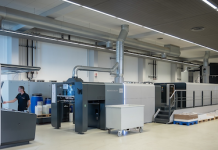How many companies have received notifications from suppliers, financial institutions, etc. that they are emailing documents to reduce their carbon footprint? Many service providers have made the decision to switch from the printed version of communication to a digital version, on the basis of unsupported environmental claims.
Two Sides, which represents The Graphic Communications Industry, is concerned that incorrect and damaging impressions are being perpetuated by these initiatives. While we clearly see the efficiency of electronic communications and encourage the reduction of waste in these initiatives, they are being promoted as ‘green’, and seek to gain credibility by purporting to aid environmental sustainability at the expense of the Print and Paper industry.
The linkage made between reducing the carbon footprint to the use of paper and helping the environment creates a false impression about the sustainability of print and paper, and creates a concern among the many companies that Two Sides represents.
Here are some interesting facts surrounding the Print and Paper industry in South Africa:
1. The Print and Paper industry has made significant advances over recent decades in terms of environmental sustainability. The use of renewable biomass-based energy has enabled the industry to avoid the use of 1.3 million tons of fossil fuels such as coal, oil and gas annually and therefore the associated carbon emissions (PAMSA, 2012).
2. All paper in South Africa is produced from plantation-grown trees, recycled paper or sugar cane fibre. Plantations are atmospheric carbon sinks which mitigate greenhouse emissions by absorbing carbon dioxide (CO2) and releasing oxygen through the natural process of photosynthesis (PAMSA, 2012). Over 250000 trees are planted every day in managed plantations around South Africa.
3. South Africa’s timber plantations, which cater for pulp and paper, furniture and other wood based-products, lock up 900 million tons of CO2, which is a key environmental service and a means of mitigating climate change (Forestry South Africa, 2011).
4. If it were not for the pulp and paper industry operating world-wide for the last 150 years, the CO2 levels in the atmosphere would be five percent higher (about half a degree in Celsius) than they are at present (National Council for Air and Stream Improvement, Special Report No 07-02. The greenhouse gas and carbon profile of the global forest products industry, February 2007).
5. The global print and paper industry accounts for only one percent of global carbon dioxide emissions (World Emissions Report Flowchart, 2010, ECOFYS).
It is increasingly clear that electronic communication, and in particular the energy requirements of the increasing worldwide network of servers, which are necessary to store all the information needed for immediate access, has a significant and growing carbon footprint. Did you know that ‘one email with a 400k attachment sent to 20 people is equivalent to burning a 100W bulb for 20 minutes’ (BBC Costing the Earth, Global Warming, April 2009) and that ‘it is estimated that the information and communications technology sector equates to two percent of global greenhouse gas emissions, similar to the airline industry, and this is expected to double by 2020’ (Gartner, 2007)? Electronic document storage must be recognised as delivering efficiency but not sustainability.
We are asking all those who do encourage the switch to electronic platforms, largely to reduce costs, to re-examine their messages, as it is certainly not proven that e-Documents provide a lower carbon footprint. In fact, with all the environmental costs of electronic communication and with many customers printing out their documents at home for reference and storage, at a higher environmental cost than a centrally produced and distributed statement, print and paper may well be the environmentally sustainable way to communicate.
Paper is a renewable and recyclable product that, if responsibly produced and consumed, is an environmentally sustainable media. In South Africa, paper recovery trends remain good with 65% of total recoverable paper being recycled (PAMSA, 2015) or to illustrate this point even better – equivalent to 3,5 million cubic metres of landfill space. That is enough to fill 1403 Olympic-sized swimming pools.
You can forward any misleading communication that you receive to the Two Sides South Africa office, which can contact the company directly to reconsider their messaging and to please ensure that, in promoting their electronic platform, they do not damage the Print and Paper industry, and jeopardise the livelihood of the many thousands of people employed therein with possibly misleading statements.
Two Sides is running an international campaign and many global organisations such as BT in the UK and HSBC and Bank of America worldwide have listened to our arguments and amended their communications. To this end, Two Sides South Africa is happy to assist in crafting a message that conveys the correct information without perpetuating incorrect messaging.





















